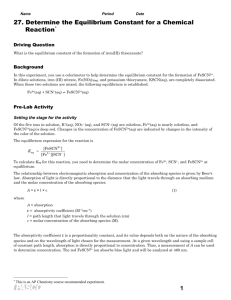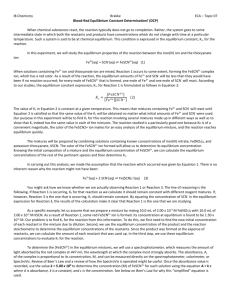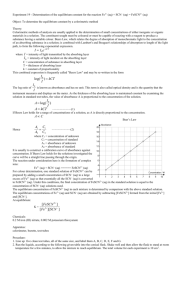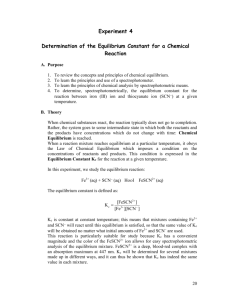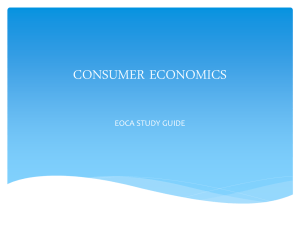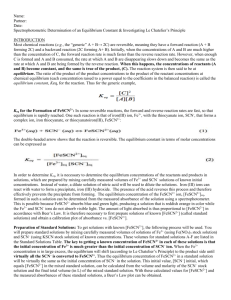Section 15.4 - SUNY Oneonta
advertisement
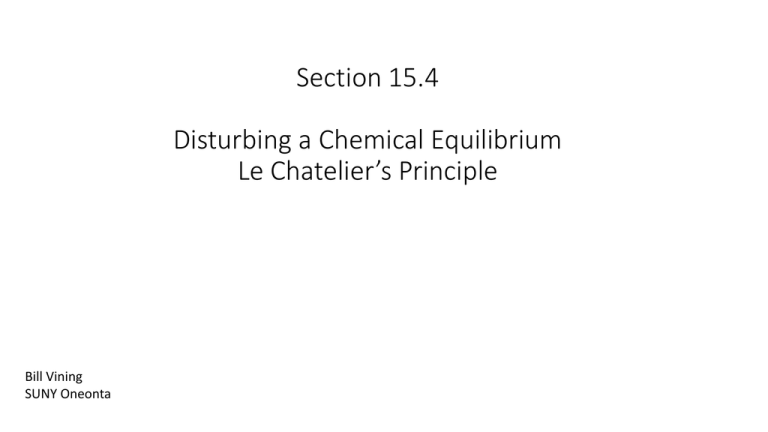
Section 15.4 Disturbing a Chemical Equilibrium Le Chatelier’s Principle Bill Vining SUNY Oneonta Equilibrium and the Equilibrium Constant In this section… a. Le Chatelier’s Principle b. Adding or removing a reactant or product c. Changing the volume of the system d. Changing the temperature Le Chatelier’s Principle General Idea: If a chemical system at equilibrium is disturbed so that it is no longer at equilibrium, the system will respond by reacting in either the forward or reverse direction so as to counteract the disturbance, resulting in a new equilibrium composition. Le Chatelier’s Principle: Water Tank Analogy response of the system perturbation system at equilibrium system NOT at equilibrium system at NEW equilibrium Addition or Removal of a Reactant or Product: Concept NOTE: K does not change when volume changes. Addition or Removal of a Reactant or Product: Graphical Addition or Removal of a Reactant or Product: Example Some FeSCN2+ is allowed to dissociate into Fe3+ and SCN– at 25 °C. At equilibrium, [FeSCN2+] = 0.0768 M [Fe3+] = [SCN–] = 0.0232 M. Additional Fe3+ is added so that [Fe3+]new = 0.0300 M and the system is allowed to once again reach equilibrium. What happens? Fe3+(aq) + SCN–(aq) FeSCN2+(aq) a. In which direction will the system shift to re-attain equilibrium? K = 142 at 25 °C Addition or Removal of a Reactant or Product: Example Initial concentrations: [FeSCN2+] = 0.0768 M, [Fe3+] = [SCN–] = 0.0232 M. Additional Fe3+ is added so that [Fe3+]new = 0.0300 M b. What will the concentrations be when equilibrium is reestablished? Fe3+(aq) + SCN–(aq) FeSCN2+(aq) K = 142 at 25 °C Pathway: 1. Write equilibrium expression 2. Construct ICE table 3. Express equilibrium concentrations in terms of initial concentrations and “x” (the amount reacting) 4. Insert into equilibrium expression and solve for the numerical value of x 5. Use x and initial concentrations to determine equilibrium concentrations Initial concentrations: [FeSCN2+] = 0.0768 M, [Fe3+] = [SCN–] = 0.0232 M. Additional Fe3+ is added so that [Fe3+]new = 0.0300 M b. What will the concentrations be when equilibrium is reestablished? Fe3+(aq) + SCN–(aq) initial change equilibrium 0.0300 0.0232 FeSCN2+(aq) 0.0768 K = 142 at 25 °C Changing the Volume: Concept NOTE: K does not change when volume changes. [N2O2] increases when volume is reduced because it has fewer moles. Changing the Volume: Example NO2 and N2O4 are in equilibrium with in a 2-L container with concentrations: [NO2] = 0.314 [N2O4] = 0.413 What will the concentrations be if the sample is transferred to a 1-L flask and equilibrium is reestablished? System shifts: Changing the Temperature: Concept When Temperature Increases: When Temperature Decreases: Changing the Temperature: Qualitative Example What will happen if Temperature Increases? Changing the Temperature: Calculating how K Changes with Temperature van’t Hoff Equation (not related to van’t Hoff factor): Sulfur dioxide reacts with oxygen to form sulfur trioxide. The equilibrium constant, Kp, for this reaction is 0.365 at 1150 K. Ho = –198 kJ/mol a. What will happen to O2 concentration when the temperature of an equilibrium system is increased? b. Estimate the value of the equilibrium constant at 1260 K.


